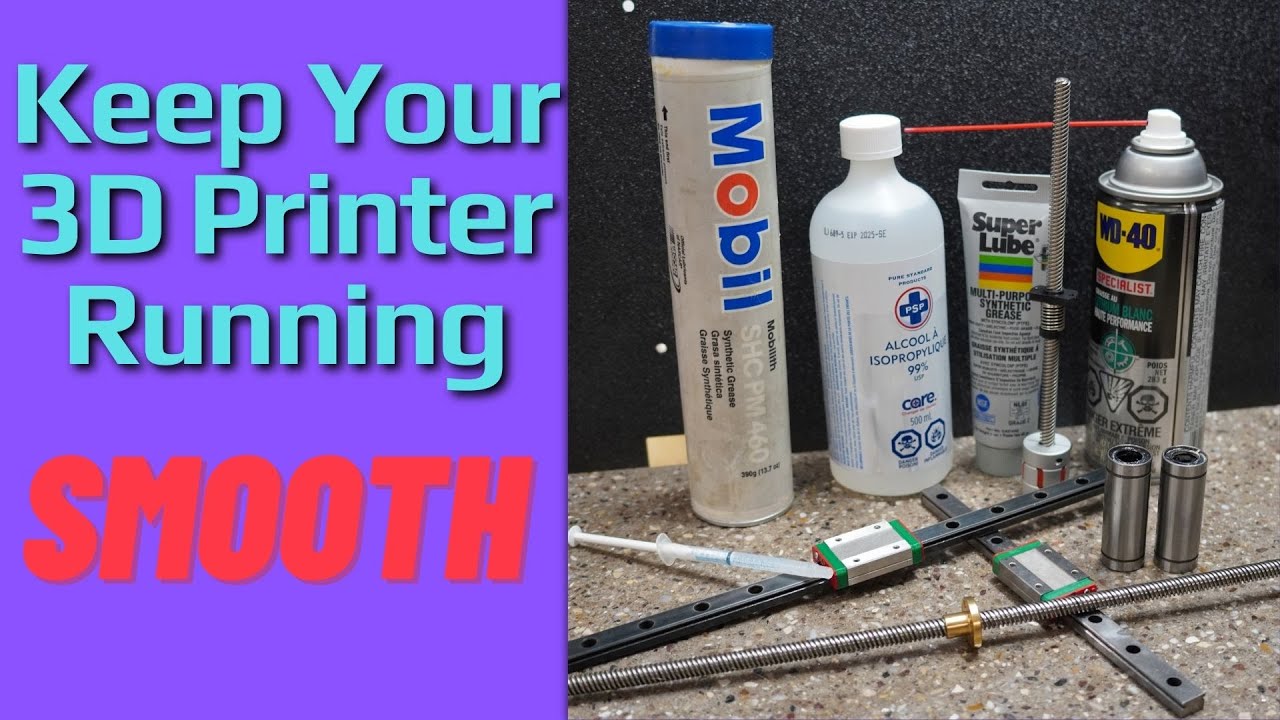When or how often do you need to lubricate your 3d printer?
The metal-on-metal contact can create friction and resistance, impacting the print quality. Signs of inadequate lubrication include banding, ghosting, and audible squeaking or noises from the printer. To prevent these issues, regular maintenance is recommended. While some suggest monthly lubrication, others, find quarterly maintenance more suitable if you don't use your printers everyday. A quick test to determine if lubrication is needed is to rub your finger on Z-axis rods; if it comes off clean, the printer may not need immediate maintenance, but if there's dust, dirt, or grime, it's likely overdue for lubrication. Incorporating regular lubrication into your maintenance routine can help ensure smooth and high-quality prints from your 3D printer.
Areas you need to lubricate on your 3D printer:
When it comes to lubricating your 3D printer, it's important to know where to apply the lubricant and why it's crucial to include this in your maintenance routine. For most printers, such as the Creality Ender 3, lubricating the Z-axis is typically sufficient. This involves applying lubricant anywhere there's metal-on-metal contact, such as the bolt and metal feed on the Z-axis. However, other printers may have additional metal bars that also require lubrication.

1. Z-axis Lead Screw: This is where the captured nut rides up and down on the x-axis. Lubricating this screw is crucial to reduce friction and maintain print quality.
2. Steel Rods: Many Cartesian printers use bearing carts and steel rods. It's important to keep these steel rods properly lubricated to ensure smooth movement of the printer components.
It's worth noting that while the bearings themselves are sealed and do not require maintenance, the steel rods they ride on should be lubricated regularly to prevent wear and tear.
What lubricant is best for 3D printer?
For 3D printers, the best lubricant is one that is specifically designed for mechanical applications and compatible with the materials used in the printer. Here are some commonly recommended lubricants:
1. PTFE-based lubricants:
These lubricants are known for their low friction properties and are suitable for use in 3D printers. They provide good lubrication while reducing the risk of contamination.
What's more, PTFE lubricant is highly recommended by Uncle Jessy, for resin 3D printers to prevent prints from sticking to the FEP sheet. He mentioned that he apply it to the FEP sheet of every new resin 3D printer he acquired and have experienced significant improvements in print adhesion since adopting this practice.
2. White Lithium-based Grease & Oil: Grease and oil are commonly used for lubricating metal-on-metal parts in mechanical devices. It provides excellent lubrication and is resistant to moisture and corrosion. The disadvantage of using both grease and oil is that they attract dust and dirt. Over time, the printer will accumulate more dust and dirt, affecting print quality, so regular cleaning is necessary. Grease tends to attract more dust and dirt compared to oil, which may affect the printer's operation.
3. Silicone-based lubricants: Silicone-based lubricants are not recommended for use in 3D printers due to several reasons. Silicone lubricants are primarily designed for plastics and rubbers, where there is plastic-on-plastic or plastic-on-metal contact. However, for metal-on-metal contact points common in 3D printers, silicone-based lubricants are not suitable. Instead, lubricants containing PTFE (Polytetrafluoroethylene) are preferred. PTFE provides better lubrication for metal components, reducing friction and wear, ensuring smooth operation and longevity. Therefore, it is advisable to avoid silicone-based lubricants and opt for alternatives containing PTFE for optimal performance of 3D printers.
4. Super Lube or synthetic lubricants: These lubricants are designed to provide long-lasting lubrication and are suitable for use in high-temperature applications. They are often used in 3D printers to lubricate moving parts such as rods, bearings, and gears.
5. WD-40: DON’T Use WD-40!! WD-40, although widely used, is not designed as a lubricant. Its primary function is to dissolve rust, oxidation, and debris from old and worn components rather than providing lubrication. Applying WD-40 to bearings or other mechanical parts can actually accelerate wear rather than lubricating them properly. Therefore, it's essential to avoid using WD-40 as a lubricant for 3D printers to maintain optimal performance and longevity of the components.
When choosing a lubricant for your 3D printer, it's important to consider factors such as compatibility with materials, temperature range, and application method. Always follow the manufacturer's recommendations and guidelines for lubricating your printer.
Step-by-Step Process of Lubricating Your 3D Printer
When it comes to 3D printers, most off-the-shelf greases are sufficient for application. The trick lies in properly applying the grease to your rods, bearings, and lead screws. So, how do you actually get the grease properly applied? Let's take a look.
-
Clean the Z-Axis Rod:
- Check the Z-axis rod by running your finger over it; if you detect dirt or debris, it needs cleaning.
- Fold paper towels and apply rubbing alcohol to clean the rod thoroughly, focusing on removing any dirt or grease buildup. Use a toothbrush with rubbing alcohol for more thorough cleaning if the rod is heavily soiled. If necessary, remove the bolt entirely for better access, but it can also be cleaned in place.
- Use dry paper towels to wipe off any remaining debris and ensure the rod is clean and dry. Inspect the rod for any remaining dirt or grime, ensuring it's completely clean before lubrication.

-
Apply Lubricant:
- Position the Z-axis rod at the top and apply three or four drops of lubricant.
- Lower the rod approximately 25% and apply a couple more drops, repeating this process at intervals until reaching the bottom.
- Work the lubricant into the metal parts by moving the rod up and down a few times to ensure even distribution.
- Be cautious not to over-lubricate, as it could lead to excessive buildup.
-
Final Check and Reassembly:
- Check for any excess lubricant or debris.
- Run the Z-axis rod up and down a few more times to distribute the lubricant evenly.
- Reassemble any components if they were removed for cleaning.
By following these steps, you can ensure smooth operation and extend the lifespan of your 3D printer. Monitor the printer's performance and cleanliness to gauge the frequency of lubrication maintenance.

